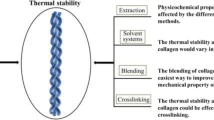Abstract
Thermal and mechanical stress conditions were applied to two model proteins, human growth hormone (hGH) and epidermal growth factor (EGF), to evaluate protein stability during the manufacturing process, focusing on protein secondary structure and aggregation. The samples were analyzed with differential scanning calorimetry (DSC), circular dichroism (CD), and size-exclusion chromatography (SEC). The monomer and aggregation contents were obtained by SEC and the proteins’ secondary structure on exposure to thermal stress was evaluated by CD. DSC showed that the transition temperature (T m) of hGH and EGF was 74.43 and 79.11 °C, respectively. The accelerated thermal stress temperature was set at 70 °C. The monomer content of hGH decreased from 97.8 to 82.3 % in response to thermal stress. However, the monomer content of EGF decreased significantly from 33.73 to 5.61 %. The hGH and EGF showed an increase in α-helix content and a decrease in β-sheet (antiparallel and parallel β-sheet). Moreover, the contents changed significantly during the first 1 h and then changed slightly for the remaining time. On the other hand, shaking stress showed that hGH was highly affected compared to EGF. The hGH monomer steadily decreased and only the half the monomer content remained at 3 h. It is suspected that the shaking stress induced hGH adsorption to the gas–liquid interface, which may facilitate protein denaturation. The results indicate that protective excipients might be necessary for inevitable stress conditions during the developmental process. The stability of each protein differed with respect to specific stress conditions. Therefore, an array of complementary analytical methods might be required to evaluate the protein stability.






Similar content being viewed by others
References
Ahrer, K., A. Buchacher, G. Iberer, and A. Jungbauer. 2006. Thermodynamic stability and formation of aggregates of human immunoglobulin G characterised by differential scanning calorimetry and dynamic light scattering. Journal of Biochemical and Biophsical Methods 66: 73–86.
Back, J.F., D. Oakenfull, and M.B. Smith. 1979. Increased thermal stability of proteins in the presence of sugars and polyols. Biochemistry 18: 5191–5196.
Bam, N.B., J.L. Cleland, J. Yang, M.C. Manning, J.F. Carpenter, R.F. Kelley, and T.W. Randolph. 1998. Tween protects recombinant human growth hormone against agitation-induced damage via hydrophobic interactions. Journal of Pharmaceutical Sciences 87: 1554–1559.
Bruylants, G., J. Wouters, and C. Michaux. 2005. Differential scanning calorimetry in life science: thermodynamics, stability, molecular recognition and application in drug design. Current Medicinal Chemistry 12: 2011–2020.
Chang, B.S., B.S. Kendrick, and J.F. Carpenter. 1996. Surface-induced denaturation of proteins during freezing and its inhibition by surfactants. Journal of Pharmaceutical Sciences 85: 1325–1330.
Frokjaer, S., and D.E. Otzen. 2005. Protein drug stability: a formulation challenge. Nature Reviews Drug Discovery 4: 298–306.
Gabrielson, J.P., M.L. Brader, A.H. Pekar, K.B. Mathis, G. Winter, J.F. Carpenter, and T.W. Randolph. 2007. Quantitation of aggregate levels in a recombinant humanized monoclonal antibody formulation by size-exclusion chromatography, asymmetrical flow field flow fractionation, and sedimentation velocity. Journal of Pharmaceutical Sciences 96: 268–279.
Hermeling, S., D.J.A. Crommelin, H. Schellekens, and W. Jiskoot. 2004. Structure-immunogenicity relationships of therapeutic proteins. Pharmaceutical Research 21: 897–903.
Kasper, J.C., and W. Friess. 2011. The feezing step in lyophilization: physico-chemical fundamentals, freezing methods and consequences on process performance and quality attributes of biopharmaceuticals. European Journal of Pharmaceutics and Biopharmaceutics 78: 248–263.
Kelly, S.M., T.J. Jess, and N.C. Price. 2005. How to study proteins by circular dichroism. Biochimica et Biophysica Acta (BBA)-Proteins and Proteomics 1751: 119–139.
Kiese, S., A. Papppenberger, W. Friess, and H.C. Mahler. 2008. Shaken, not stirred: Mechanical stress testing of an IgG1 antibody. Journal of Pharmaceutical Sciences 97: 4347–4366.
Meyer, B.K., A. Ni, B. Hu, and L. Shi. 2007. Antimicrobial preservative use in parenteral products: past and present. Journal of Pharmaceutical Sciences 96: 3155–3167.
Sreerama, N., and R.W. Woody. 2004. Computation and analysis of protein circular dichroism spectra. Methods in Enzymology 383: 318–351.
Tian, F., S. Sane, and J.H. Rytting. 2006. Calorimetric investigation of protein/amino acid interactions in the solid state. International Journal of Pharmaceutics 310: 175–186.
Vázquez-Rey, M., and D.A. Lang. 2011. Aggregates in monoclonal antibody manufacturing processes. Biotechnology and Bioengineering 108: 1494–1508.
Wang, W. 2000. Lyophilization and development of solid protein pharmaceuticals. International Journal of Pharmaceutics 203: 1–60.
Wang, W. 2005. Protein aggregation and its inhibition in biopharmaceutics. International Journal of Pharmaceutics 289: 1–30.
Wiesbauer, J., M. Cardinale, and B. Nidetzky. 2013. Shaking and stirring: Comparison of controlled laboratory stress conditions applied to the human growth hormone. Process Biochemistry 48: 33–40.
Xie, G., and S.N. Timasheff. 1997. The thermodynamic mechanism of protein stabilization by trehalose. Biophysical Chemistry 64: 25–43.
Zhang, Y., and P.S. Cremer. 2006. Interactions between macromolecules and ions: The Hofmeister series. Current Opinion in Chemical Biology 10: 658–663.
Zheng, J.Y., and L.J. Janis. 2006. Influence of pH, buffer species, and storage temperature on physicochemical stability of a humanized monoclonal antibody LA298. International Journal of Pharmaceutics 308: 46–51.
Acknowledgments
This study was supported by Basic Science Research Program through the National Research Foundation of Korea (NRF) funded by the Ministry of Education, Science and Technology (2012002399) and a Grant of the Korean Healthcare technology R&D Project, Ministry of Health & Welfare, Republic of Korea (Grant No.: A103017).
Author information
Authors and Affiliations
Corresponding author
Rights and permissions
About this article
Cite this article
Lim, J.Y., Kim, N.A., Lim, D.G. et al. Effects of thermal and mechanical stress on the physical stability of human growth hormone and epidermal growth factor. Arch. Pharm. Res. 38, 1488–1498 (2015). https://doi.org/10.1007/s12272-014-0521-3
Received:
Accepted:
Published:
Issue Date:
DOI: https://doi.org/10.1007/s12272-014-0521-3




